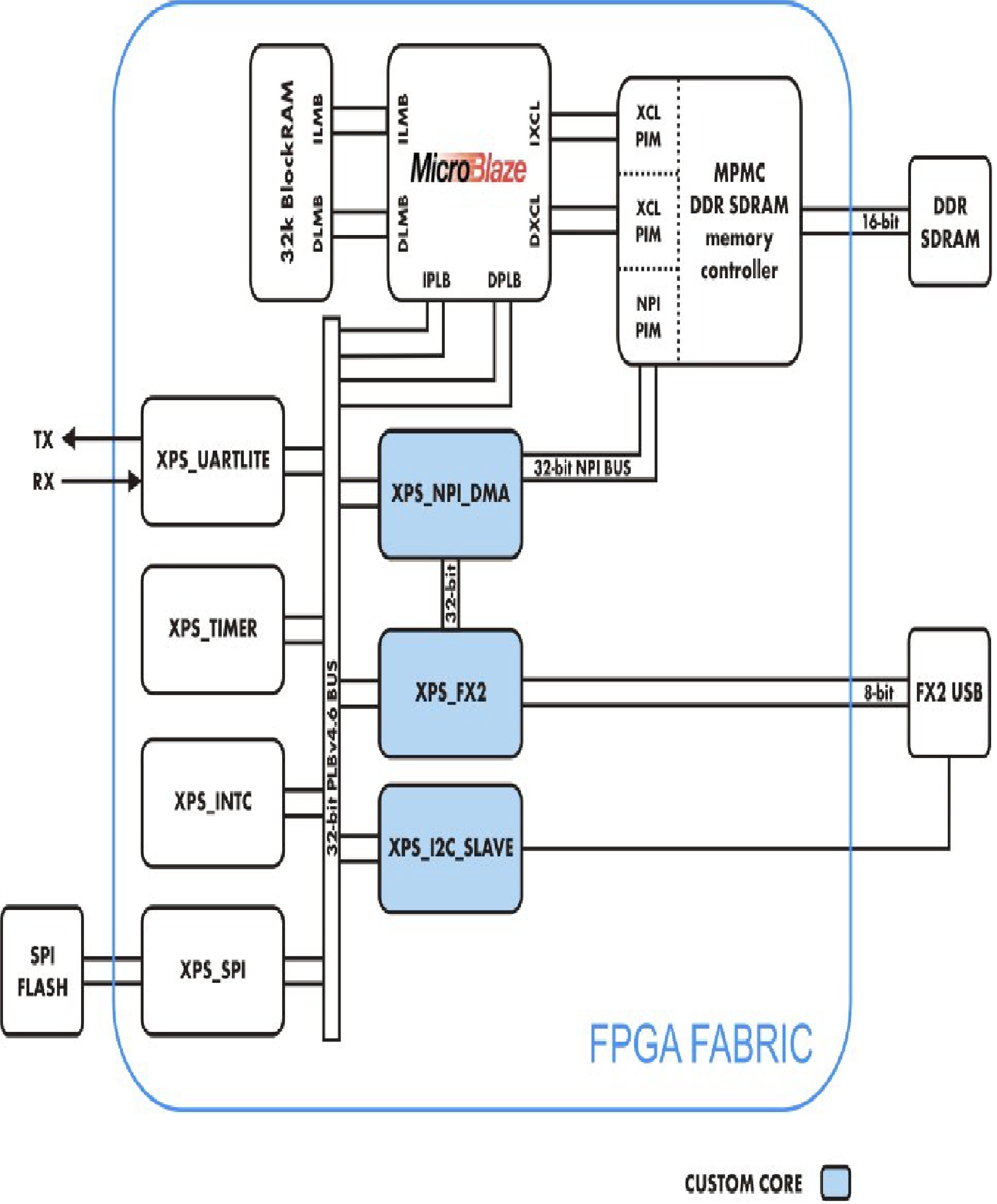The Xilinx FPGA itself on the Trenz Electronic USB FX2 modules is blank when powered off. To define an FPGA functionality, a Logic Architecture Layer (also called FPGA image or FPGA bitstream) should be defined and loaded into the device at power-on.
The Logic Architecture Layer is defined in a .mcs or .bit file (.bin file is also possible). The Logic Architecture Layer is defined (and .bit/.bin/.mcs are created) using the Xilinx software applications:
- XPS, if MicroBlaze is not used
EDK (or both), if MicroBlaze is used.
The Logic Architecture Layer could be loaded from SPI Flash or from JTAG and/or USB connections. See here.
A TE USB FX2 module comes with SPI Flash preloaded with a reference design.
Those preloaded image is just for getting started demo. For real designs:
- it is expected that these image could be replaced by the customer;
- it is expected that these image could be used by the customer as starting point.
The use of preloaded Reference Architecture Layer is a user choice. If the user runs:
- customer Logic Architecture Layer (on the FPGA, with or without MicroBlaze) and
- the reference firmware (or derived compatible firmware) on FX2 USB microcontroller
the and SPI Flash Commands are available through C++/.NET .
MicroBlaze API Commands (MB Commands) are available only if Reference Architecture Layer (or derived compatible Logic Architecture Layer). and SET_INTERRUPT command (two ) could be used without Reference Architecture Layer (or derived compatible Logic Architecture Layer), but they are usually usefull only with Reference Architecture Layer.
Preloaded Logic Architecture Layer (in SPI Flash): Reference Architecture Layer description
The reference design architecture was built using Xilinx Embedded Development Kit (EDK). Basically, it is an embedded system on a chip with a Xilinx MicroBlaze 32-bit soft microprocessor. The MicroBlaze (MB) initializes and sets up the system.
Standard EDK cores are used to implement a serial interface (XPS_UARTLITE), an SPI FLASH interface (XPS_SPI), a timer / counter block (XPS_TIMER) and an interrupt controller (XPS_INTC).
Besides standard IP cores, the reference architecture contains three custom IP cores:
- XPS_I2C_SLAVE: forwards commands coming from the USB bus towards the MicroBlaze;
- XPS_NPI_DMA: custom DMA between DDR SDRAM and other multiple sources;
- XPS_FX2: used for high speed bidirectional communication between the FPGA and a host PC.
XPS_I2C_SLAVE custom IP block
It is a logic block for low speed bidirectional communication between the FPGA and a host PC. It is usually used for command, settings and status communication. It contains 6 × 32-bit memory mapped registers:
- 3 for host => FPGA communication (FX22MB registers; FX22MB register 0 (aka FX22MB_REG0) is fundamental for )
- 3 for FPGA => host communication (MB2FX2 registers)
When the host sends commands to the MicroBlaze (MB) soft embedded processor, an interrupt is triggered. When the MB writes data to MB2FX2_REG0, the interrupt (INT0) is sent to the Cypress EZ-USB FX2LP USB microcontroller (FX2 microcontroller from now on). When the FX2 microcontroller receives an interrupt, it reads all MB2FX2 registers. The FX2 microcontroller firmware elaborates these registers values.
Only for , the user should personally set an (FX2 microcontroller) interrupt, send a MB Commands, get an (FX2 USB microcontroller) interrupt. For all others MB Commands the interrupts are automatically managed by FX2 microcontroler firmware. See .
VHDL code: here.
MicroBlaze Driver code: here.
XPS_NPI_DMA custom IP block
It is a high speed DMA (direct memory access) engine which connects to the MPMC (Multi-Port Memory Controller) VFBC (Video Frame Buffer Controller) port. It enables high speed data streaming to/from external memory (DDR SDRAM) and multiple sources. It can be controlled by a processor using 6 × 32-bit memory mapped registers attached to the PLB (peripheral local bus). For more information about registers, see Xilinx LogiCORE IP Multi-Port Memory Controller (MPMC) data sheets (Xilinx DS643), Video Frame Buffer Controller PIM section.
When data is sent from the USB-host to a USB FX2 module high-speed endpoint (high speed communication channel), it is automatically stored into the RAM by the custom built DMA engine (XPS_NPI_DMA) at a specified buffer location. The reference design software running on the MicroBlaze verifies the transferred data at the end of transmission and sends to the USB host a notification about the data test (passed / failed).
VHDL code: here.
MicroBlaze Driver code: here.
XPS_FX2 custom IP block
It is a logic block for high speed bidirectional communication between the FPGA and a host PC. It contains 2 kbyte FIFOs for data buffering. More information about the 5 × 32-bit memory mapped registers is contained in the #project_root#/pcores/xps_fx2_v1_00_a/doc/ folder of the reference design project folder.
When data is sent form a USB FX2 module high-speed endpoint to the USB host, it is automatically fetched from the RAM via the custom DMA engine (XPS_NPI_DMA) and forwarded to the XPS_FX2 core in 1-kbyte packets. MicroBlaze throttles the throughput to prevent XPS_FX2 TX FIFO overflow.
VHDL code: here.
MicroBlaze Driver code: here.
Source Code of the reference architecture
The source code of the reference architecture of the Trenz Electronic USB FX2 Technology Stack is released on GitHub (TE0300, TE0320 and TE0630).
